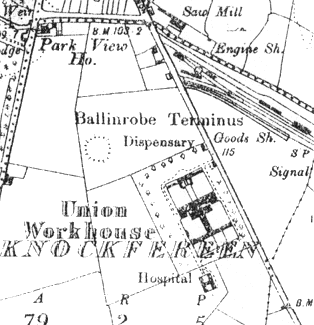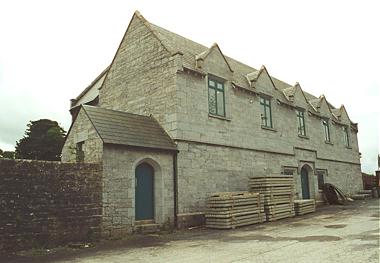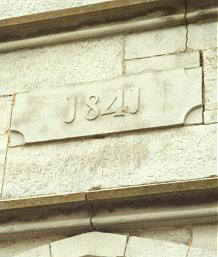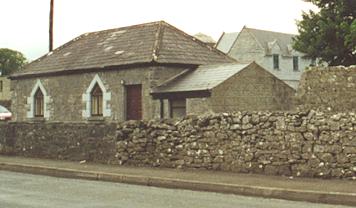Ballinrobe, Co. Mayo
Ballinrobe Poor Law Union was formed 16th November 1839 and covered an area of 298 square miles. Its operation was overseen by an elected Board of Guardians, 26 in number, representing its 14 electoral divisions as listed below (figures in brackets indicate numbers of Guardians if more than one):
Co. Mayo:
Ballindine (3), Ballinrobe (3), Burriscarra, Claremorris (3), Cong (3), Hollymount (2), Kilmain (2), Kilmolara, Mayo, Partry, Robeen (2), Shrule.
Co. Galway:
Balloghholla, Ross (2).
The Board also included 8 ex-officio Guardians, making a total of 31.
The population falling within the union at the 1831 census had been 74,812 ranging from Balloghholla (population 2,028) to Ballinrobe itself (9,415).
The new workhouse, built in 1840-42, occupied a 6-acre site on Kilmaine Road to the south-east of the town. It was designed to hold 800 inmates and its construction cost £7,000 plus £1,400 for fixtures and fittings etc. It was declared fit for the admission of paupers on 24th March 1842 and admitted its first inmates two months later on 26th May 1842.
The building was constructed to one of George Wilkinson's standard designs with an entrance block at the north containing a board-room, offices etc. Behind this stood the large main block, with women's accommodation to one side and men's to the other. At the rear were wash-rooms, kitchens, store rooms and so on. To the south of the main workhouse buildings stood a small fever hospital block built in 1847. At the north of the site, on the main road, stood a dispensary. The site layout can be seen on the map below.

Ballinrobe workhouse site.

Ballinrobe entrance block from the north-east, 2000.
© Peter Higginbotham.

Ballinrobe date stone, 2000.
© Peter Higginbotham.

Ballinrobe workhouse dispensary, 2000.
© Peter Higginbotham.
In common with other unions in Ireland, Ballinrobe suffered considerably during the famine years 1845-50. The workhouse was greatly overcrowded with over two thousand inmates at the height of the famine. Fever ravaged in February 1847 after an infected person was admitted. Dysentery was also common. The Mayo Constitution of 23rd March 1847 reported:
In a single week in April 1849, ninety-six people died. Deceased inmates were buried in shallow unmarked graves beyond the boundary wall to the south-west of the site.
Much of the main block was destroyed by fire during the civil war in 1922, although the entrance and dispensary blocks have survived. In 1993, small factory units were erected on the derelict part of the site. The surviving original buildings are now used as a local council depot and offices. Traces of the workhouse graveyard can also still be found.
Inmates
Records
Note: many repositories impose a closure period of up to 100 years for records identifying individuals. Before travelling a long distance, always check that the records you want to consult will be available.
- Local History Department, Castlebar Central Library, Castlebar, Co Mayo.
Bibliography
- The Famine in Mayo 1845-1850 compiled and edited by Ivor Hamrock. Mayo County Council, 1998.
Links
- None.
Unless otherwise indicated, this page () is copyright Peter Higginbotham. Contents may not be reproduced without permission.


